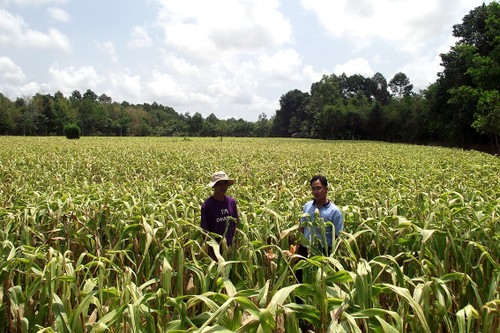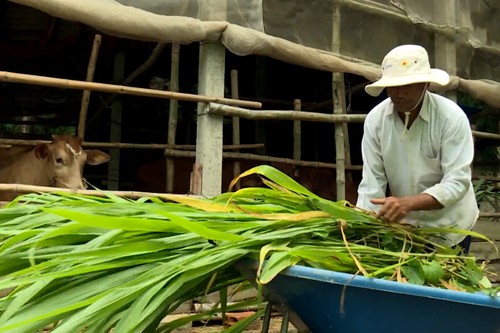 Thach Chen of Ngoc Bien commune stands in his nearly harvested corn field. (Photo: VOV) Thach Chen of Ngoc Bien commune stands in his nearly harvested corn field. (Photo: VOV) |
More than 81% of the population of Ngoc Bien commune in Tra Cu district are Khmer.
Although the commune has been affected by the pandemic, villagers are determined to achieve the rural building targets. Unproductive sandy areas have been converted from rice to corn, green beans, peanuts, and chili peppers.
Each hectare now earns more than 2,200 USD per crop, 2 or 3 times as much as when it was planted with rice.
Thach Chen, a farmer who lives in Tha La hamlet in Ngoc Bien commune, said, “Since the commune began to implement the new-style rural building program, roads and productivity have much improved. Now, thanks to signing contracts with businesses to sell our produce at higher prices, our lives have become more comfortable.”
Huynh Van Truong, Secretary of the commune’s Party Committee, said that over the years, local Khmer people have restructured their crops and used intercropping and crop rotation to increase their yields.
To reduce the number of poor and near-poor households in the area, the commune’s Steering Committee has classified households and recommended solutions for each type of household.
Truong said the administration has done its best to boost the income from every cultivated area to raise the villagers’ living standard and reduce the number of poor households. When the new-style rural building program began, poor households accounted for more than 30% of the total. Now the figure is just 2%.
According to Truong, Ngoc Bien commune is now applying the enhanced criteria for new-style rural areas.
“We’ve outlined various measures matched to the needs of each hamlet and each household, and plans to provide production capital to support them. Priority is given to these people to sustainably reduce poverty, one of the targets of the National Program on New-style Rural Building,” said Truong.
Tan Hung has met the enhanced criteria of a new-style rural commune. All roads to the hamlets have been paved, and along the roads are spacious houses surrounded by fruit orchards.
 Ngoc Bien villager Thach Thuong and his cow herd sponsored by the provincial Poverty Reduction Fund (Photo: VOV) Ngoc Bien villager Thach Thuong and his cow herd sponsored by the provincial Poverty Reduction Fund (Photo: VOV) |
In Trung Tien hamlet, a former revolutionary base, despite the coronavirus pandemic, farmers are still working the fields, because they know how to protect themselves from the disease. Irrigation and road systems continue to be upgraded and expanded.
Elderly Lam Thi Tha says that it used to take locals all day to go to the district market. Since the National Target Program on New-style Rural Building was implemented, every house has electricity and tap water and the village roads are clear and clean, says Tha, adding that if there was no pandemic, the village would have changed a lot more.
“Before the region was transformed, we had to walk to the market because the road was just a path. Now all the roads have been paved, making trading much easier. There have been many changes. It’s very easy now to go buy things,” said Tha.
Tan Hung commune is trying to become a new rural role model and eliminate poor households by 2025.
After 11 years of building new rural areas, 78 of 85 communes in Tra Vinh province have been recognized as having completed the new rural criteria, and the per capita income there is approaching 3,000 USD a year.
Living standards continue to improve, especially in areas with a large Khmer population. Tra Vinh’s poverty rate has decreased to 0.8%, and the poverty rate among Khmer households has reduced to 1.7%.